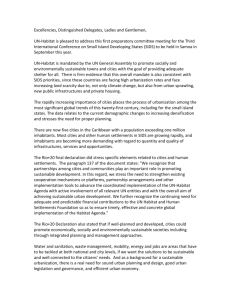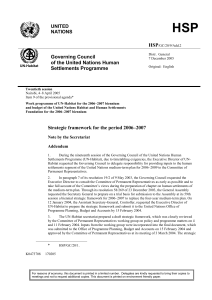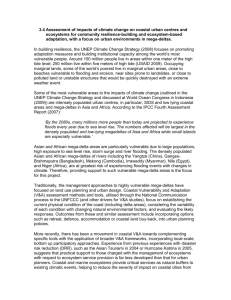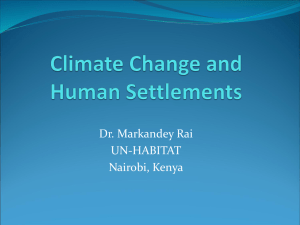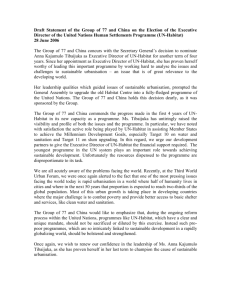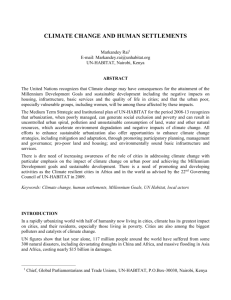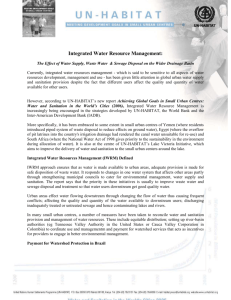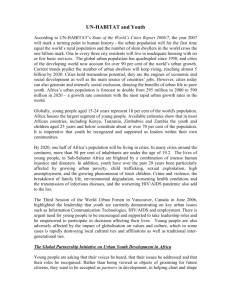HSP - Division of Conference Services
advertisement
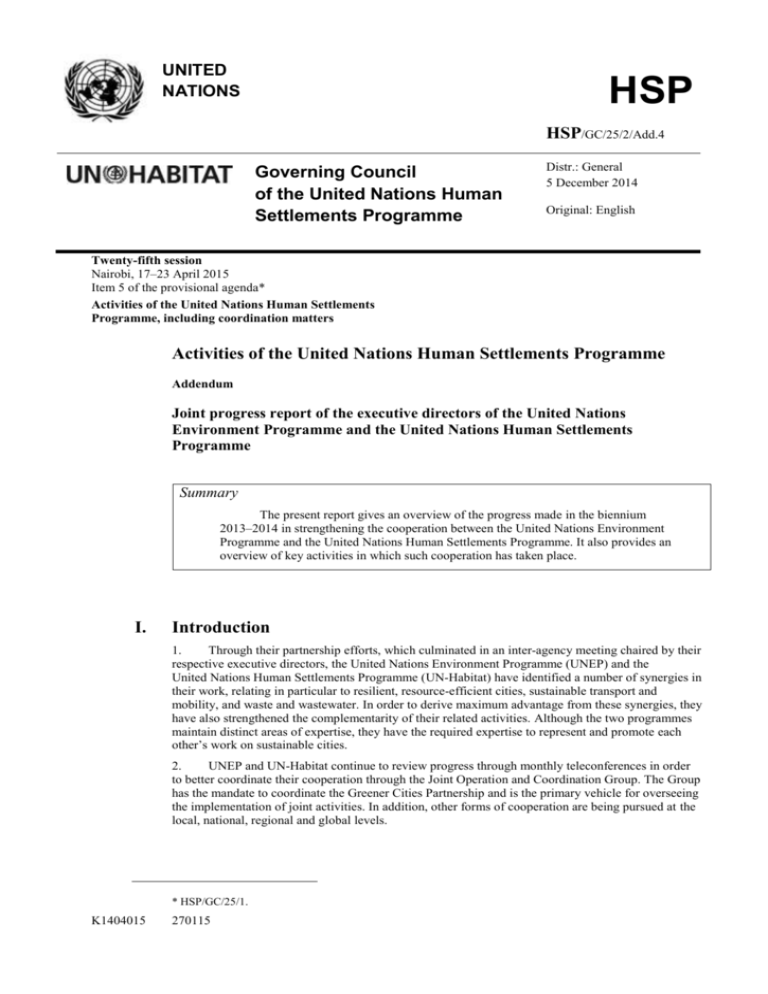
UNITED NATIONS HSP HSP/GC/25/2/Add.4 Governing Council of the United Nations Human Settlements Programme Distr.: General 5 December 2014 Original: English Twenty-fifth session Nairobi, 17–23 April 2015 Item 5 of the provisional agenda* Activities of the United Nations Human Settlements Programme, including coordination matters Activities of the United Nations Human Settlements Programme Addendum Joint progress report of the executive directors of the United Nations Environment Programme and the United Nations Human Settlements Programme Summary The present report gives an overview of the progress made in the biennium 2013–2014 in strengthening the cooperation between the United Nations Environment Programme and the United Nations Human Settlements Programme. It also provides an overview of key activities in which such cooperation has taken place. I. Introduction 1. Through their partnership efforts, which culminated in an inter-agency meeting chaired by their respective executive directors, the United Nations Environment Programme (UNEP) and the United Nations Human Settlements Programme (UN-Habitat) have identified a number of synergies in their work, relating in particular to resilient, resource-efficient cities, sustainable transport and mobility, and waste and wastewater. In order to derive maximum advantage from these synergies, they have also strengthened the complementarity of their related activities. Although the two programmes maintain distinct areas of expertise, they have the required expertise to represent and promote each other’s work on sustainable cities. 2. UNEP and UN-Habitat continue to review progress through monthly teleconferences in order to better coordinate their cooperation through the Joint Operation and Coordination Group. The Group has the mandate to coordinate the Greener Cities Partnership and is the primary vehicle for overseeing the implementation of joint activities. In addition, other forms of cooperation are being pursued at the local, national, regional and global levels. * HSP/GC/25/1. K1404015 270115 HSP/GC/25/2/Add.4 3. During the biennium 2013–2014, cooperation between the two programmes was also significantly strengthened by an external review of the Partnership Framework for the period 2008–2013 and the consequent development and launch of the Greener Cities Partnership. II. General cooperation between the United Nations Human Settlements Programme and the United Nations Environment Programme A. External review 4. With their complementary mandates in the fields of urban development and the global environment, UN-Habitat and UNEP have been cooperating over the years with the goal of mainstreaming environmental considerations into local, national and global urban policymaking, so that urban perspectives can be incorporated into environmental policymaking at the local, national and global levels and attention brought to the linkages between local and global environmental issues. Increased importance has been given to the need to integrate urban environmental considerations into the work of both programmes. Under the Partnership Framework for 2008‒2013, UN-Habitat and UNEP revitalized their cooperation with a view to providing better and more extensive services to local and national governments. The objective was to enable cities to better assess and prioritize local environmental concerns and to have a voice in national and global environmental debates, in particular with respect to climate change. Support for countries and cities in their endeavour to implement global standards, agreements and conventions will enable them to forge links between global concerns and local issues. 5. Given that the existing Partnership Framework was to end in December 2013, a high-level meeting between the executive directors of UNEP and UN-Habitat was held in March 2013 to take stock of the collaboration of the programmes and to explore ways of strengthening collaboration and the joint delivery of aspects of their respective programmes in the future. At that meeting, the executive directors reaffirmed the mutual benefits of collaboration and agreed that a new, more effective cooperation framework should be developed as a way forward. It was decided that an external review should be conducted to guide the process of formulating such future cooperation, with a particular emphasis on assessing progress, identifying the results achieved and pinpointing the challenges encountered on the way. The results of the review fed directly into the development of a new partnership between the two programmes. 6. The external review found that the Partnership Framework had been useful in promoting interagency dialogue and cooperation, to which the staff of both UNEP and UN-Habitat attached considerable importance. At the same time, however, there was only moderate awareness of the Partnership Framework at the headquarters of both programmes, and awareness was generally low in the regional offices. The review also found that regional inter-agency collaboration was always stronger when the regional offices of the two programmes were in the same city. 7. Staff at both UNEP and UN-Habitat were interested in strengthening the partnership, but foresaw several barriers: first, the lack of a shared vision; second, the lack of a common understanding about the comparative advantages of each programme; and, third, the lack of incentives for collaboration. Lastly, the review found that, although the Joint Operation and Coordination Group had been useful, its system of non-rotating membership imposed a burden on the individuals constituting the Group and limited outreach to other units within the programmes. 8. As a result, the external review offered a number of recommendations for improving the partnership during the period 2014–2016. While existing activities should be carried through to completion, new strategic programmatic priorities should guide future collaboration. Such priorities should include, first, a shared vision with key messages; second, clear descriptions of the comparative advantage and added value of each of the programmes; third, an implementation plan with targets, indicators and clear roles; and, fourth, a budgeted monitoring and evaluation plan. UNEP and UN-Habitat were also advised to improve the linkages between global priorities and regional work; to strengthen, diversify and rotate the leadership of the Joint Operation and Coordination Group; and to improve inter-agency communication. Taking this even further, the review suggested that the programmes should develop a full-scale policy of collaboration. Lastly, the programmes were advised to mainstream the work of the partnership in their programming instruments and to take advantage of possible funding opportunities available under the sixth tranche of the Global Environment Facility. 2 HSP/GC/25/2/Add.4 B. Greener Cities Partnership 9. The Greener Cities Partnership was launched at the World Urban Forum in April 2014. It was set up in response to the call by the executive directors of UNEP and UN-Habitat to raise the visibility and profile of the cooperation between the two programmes in the lead-up to the United Nations Conference on Housing and Sustainable Urban Development (Habitat III), to be held in 2016, thereby more clearly demonstrating the benefits and added value of such cooperation. The partnership builds directly on the independent review conducted in 2013. Its programme priorities were selected through a systematic review and consultation process based on the importance of the respective activities in the global agenda and their potential in leveraging the strengths of each programme. Implementation mechanisms include the development of baselines and standards on green cities, the development of a knowledge platform on best practices and the delivery of joint advisory services to national and local governments. 10. Priority areas include, first, resilient, resource-efficient cities; second, sustainable transport and mobility; and, third, waste and wastewater management. 11. In the area of resilient and resource-efficient cities, the two programmes aim to foster a better understanding of the impact that resource efficiency will have on the resilience of cities. This priority area has a global focus, and two principal joint activities have been held to date. First, UNEP and UN-Habitat have joined forces in the development of a harmonized framework to monitor resource use at the city level. This activity is part of the work programme of the UNEP-led Global Initiative for Resource-Efficient Cities. UN-Habitat is fully engaged in the development of the framework and has offered to pilot-test it in Kigali and in Da Nang, Viet Nam. The second activity is the development of a proposal under the 10-year framework of programmes on sustainable consumption and production patterns, focusing on the sustainable use of land in urban areas. UN-Habitat is taking the lead in the development of the proposal, which will complement the Sustainable Building and Construction programme of the 10-year framework. In keeping with the procedure agreed upon by the board of the 10-year framework, the concept note of the proposal will be submitted to the framework secretariat for its review and will then be endorsed by the board before its inclusion in the list of programmes under the 10-year framework. 12. In the area of transport and mobility, UNEP and UN-Habitat are supporting the Kenyan climate action plan, with funding from the Department for International Development of the United Kingdom of Great Britain and Northern Ireland, for a joint project to reduce climate emissions by the transport sector in the major cities of Kenya. In addition, UNEP, UN-Habitat and the World Bank have recently concluded the first Africa Sustainable Transport Forum, which brought experts and ministers together to prioritize and review key actions to promote sustainable transport in Africa. The Forum adopted an action plan for sustainable transport in Africa. 13. In the area of wastewater and waste management, an inter-agency agreement has been concluded under the Global Monitoring Mechanism for Waste Water and Water Quality. A mapping exercise is also under way to explore the potential for joint activities in a number of cities, primarily in Asia and the Pacific and in Africa. III. Key activities A. Greener Cities Partnership 1. Resilient, resource-efficient cities 14. By focusing on resilient and resource-efficient cities, UN-Habitat and UNEP aim to foster a better understanding of the impact that resource efficiency can have on the resilience of cities and to build political support for the establishment of related, innovative initiatives that involve the participation of a broad range of stakeholders. Within this broad topic, the two programmes are focusing their attention on three specific areas: city-level ecosystem-based adaptation; integrated resource flows; and the reduction of urban sprawl. Working together, UN-Habitat and UNEP will establish baseline measurements for city-wide resource flows, review city and metropolitan legislative and planning frameworks and implement demonstration projects that improve city-level resilience and resource efficiency through infill, densification, brownfield redevelopment and revised city-region plans. 15. UN-Habitat and UNEP have already begun jointly to mobilize resources for the focus area. One such possibility is the newly opened funding window, under the sixth tranche of the Global Environment Facility, for an integrated cities approach. The ecosystem-based adaptation component has already been approved by the Global Environment Facility for implementation in Asia (Bhutan, 3 HSP/GC/25/2/Add.4 Cambodia, the Lao People’s Democratic Republic and Myanmar) and in Latin America and the Caribbean (El Salvador, Jamaica and Mexico). A similar proposal for Nepal is under consideration by the two programmes, which have submitted yet another idea for ecosystem-based adaptation to the International Climate Initiative. 16. In addition, UN-Habitat is seeking funding for the measurement, on a global scale, of the geographical expansion of urban areas and its correlation with levels of per capita resource use. This will help cities to understand the trade-offs involved in pursuing different settlement patterns and make evidence-based decisions about how to guide future growth in a spatially appropriate manner. UN-Habitat is also gauging the interest of a number of city regions around the world in participating in the pilot of a demonstration project on reducing urban sprawl, which would be linked to a proposal for the 10-year framework of programmes on sustainable consumption and production patterns. 2. Sustainable transport and mobility 17. In the area of sustainable transport and mobility, the two programmes are taking the lead on interventions that fall within their respective areas of comparative advantage. UN-Habitat is guiding the work on urban planning to help cities avoid unsustainable patterns of transport in the first place, before their infrastructure becomes locked in. UNEP is leading the technology and policy component of this work, helping cities and countries to introduce technologies, policies and standards for a transport sector with low emissions that is more sustainable, and both programmes are leading efforts to help cities shift to more sustainable modes of transport. 18. UNEP and UN-Habitat are jointly implementing the transport component of the Kenya climate action plan supported by the Department for International Development of the United Kingdom. UNEP will focus on developing a Kenyan automotive fuel economy standard, a non-motorized transport policy, along with investment decisions in Nairobi, while UN-Habitat will focus on integrated transport planning in Kiambu as an initiative towards the development of an integrated public transport policy for the Nairobi metropolitan area. These efforts are building on the project for the promotion of sustainable transport solutions for East African cities, currently being implemented by UN-Habitat. 19. UNEP, UN-Habitat, the World Bank and the Government of Kenya organized the inaugural session of the Africa Sustainable Transport Forum from 27 to 31 October at the United Nations Office at Nairobi. The ministerial session was opened by the President of Kenya, Mr. Uhuru Kenyatta, and the Secretary-General of the United Nations and was attended by representatives of 43 African countries. The week also featured a two-day expert session and several discussions and training sessions on sustainable transport in Africa. 20. The Africa Sustainable Transport Forum adopted an action framework for sustainable transport in Africa, which included 13 key priority actions with deadlines. It was decided that UNEP would continue to host the Africa Sustainable Transport Forum secretariat, with support from UN-Habitat and the World Bank. Those bodies would also be involved in supporting the implementation of the Forum’s action framework. 3. Waste and wastewater 21. The third focus of the partnership is on waste and wastewater. It builds on four existing initiatives: the Global Partnership on Waste Management, which is an open-ended partnership that UNEP launched in 2010; the report Solid Waste Management in the World’s Cities: Water and Sanitation in the World’s Cities 2010; the United Nations task force on wastewater management; and the Global Wastewater Initiative, which is co-chaired by the two programmes. The objective of this focus area is for selected cities to have integrated waste-management strategies that include both solid waste and wastewater management. 22. UN-Habitat and UNEP are currently consulting key stakeholders to identify cities with a variety of population densities and growth rates. Ultimately, the aim is for at least 10 such cities to develop integrated waste-management strategies and to implement at least two field projects that demonstrate the feasibility of a comprehensive waste strategy, and also to establish a system for the dissemination of knowledge generated by the pilot projects. 23. The Global Wastewater Initiative, chaired by both programmes, organized an event in Stockholm in August 2014 to share knowledge and promote wastewater management and reuse. UNEP and UN-Habitat are also working together on the development of an expanded monitoring framework for wastewater and water quality, funded by the Swiss Agency for Development and Cooperation, and a checklist and guidelines for gender risk assessment on wastewater that will take stock of existing wastewater projects in Georgia, Ghana and the United Republic of Tanzania. Lastly, 4 HSP/GC/25/2/Add.4 in collaboration with the Global Water Partnership and the United Nations Educational, Scientific and Cultural Organization, the two programmes jointly chaired a technical session on wastewater management and water quality during the fifth Africa Water Week, organized by the African Ministers’ Council on Water in Dakar in May 2014. B. Other partnerships 24. UN-Habitat and UNEP both lent technical support to the Open Working Group of the General Assembly on Sustainable Development Goals, in particular through their joint leadership of a group of more than 15 United Nations agencies on the topic of sustainable cities and human settlements. In October 2013, UN-Habitat and UNEP led the drafting of an issue brief for Member States in the Open Working Group that took stock of current challenges and opportunities related to sustainable cities and human settlements, and also summarized various proposals on how this topic should be tackled in the sustainable development goals. Working together, the two programmes led the inter-agency group in several exercises, with the aim of consolidating the targets that had been proposed by the United Nations system and other international organizations under a possible goal for sustainable cities and human settlements. They were also later to reformulate, consolidate and prioritize the shortlist of targets proposed by the States members of the Open Working Group. 25. UNEP and UN-Habitat continued to collaborate on the UN-Habitat-led Cities and Climate Change Initiative and to provide direct support to cities in dealing with the effects of climate change. Building on existing activities in Lami, Fiji, they undertook a climate change vulnerability assessment at city level and produced a comprehensive report on options for ecosystem-based adaptation and climate-change action, including the rehabilitation of mangroves. In addition, climate-change vulnerability assessments were prepared for Apia and for Makassar, Indonesia, through collaborative exercises. For Apia, this involved the Cities and Climate Change Initiative of UN-Habitat, the Freshwater and Marine Ecosystems Branch, the Division of Environmental Policy and the Pacific Office of UNEP and the Secretariat of the Pacific Regional Environment Programme; and, for Makassar, the Cities and Climate Change Initiative of UN-Habitat, the UNEP Regional Office for Asia and the Pacific and the United Nations Development Programme (UNDP). 26. At the seventh session of the World Urban Forum, UN-Habitat convened a meeting of Cities and Climate Change Initiative partners, including UNEP, to review its progress over the previous four years at both the normative and operational levels and to consider how to create a more formal advisory structure to support the initiative. 27. Under the framework of the UNEP-led Global Initiative for Resource-Efficient Cities, cooperation between the two programmes is focusing on two components: first, the integration of resource efficiency in city development plans and policies; and, second, the development of measurement tools and indicators for assessing the resource efficiency of cities. UN-Habitat will provide advice on the choice of cities for the pilot-testing exercise related to the use of the measuring and tracking resource, and will be closely associated with the overall capacity-building component of these two focus areas. In addition, UN-Habitat continues to serve on the advisory board of the Global Initiative, providing strategic support for its future development. 28. UN-Habitat and UNEP are also collaborating in the domain of green buildings for sustainable housing. They have been working on a joint publication on green buildings in social housing, which is intended to link the social housing sector with green building principles, and to identify policy-related, institutional, financial and technical instruments or actions to support sustainable buildings. The publication’s findings will be implemented within the framework of the UN-Habitat Global Network for Sustainable Housing. 29. UN-Habitat and UNEP are also continuing their joint efforts to coordinate their programmes of activity and to formulate collaborative initiatives in the field of green buildings for sustainable and affordable housing, with a view to contributing to the programme on sustainable buildings and construction, under the 10-year framework, and the Global Housing Strategy. In particular, UN-Habitat participated in the task force on greening the building sector supply chain, under the UNEP Sustainable Buildings and Climate Initiative, which resulted in the technical report Greening the Building Supply Chain. UN-Habitat also served on the steering committee for recent pilot projects in Bangladesh and India under the Sustainable Social Housing Initiative. 5 HSP/GC/25/2/Add.4 C. Regional highlights 30. In Africa, under a UN-Habitat programme with Kogi State, Nigeria, UNEP has developed a component for the development of an integrated solid waste management plan, and a holistic, strategic and systematic approach to solid waste management based on the waste management hierarchy model: “Avoid, reduce, reuse, recycle, recover and dispose”. 31. Discussions are currently under way on coastal activities in Côte d’Ivoire and waste management activities in Kenya. In addition, through a new Africa-China collaboration funded by Tongji University in Shanghai, UNEP and UN-Habitat are also planning to guide a series of joint training sessions on urban environment issues in 10 African cities, as a component of the UNEP and UN-Habitat Greener Cities Partnership. Based on the initial lessons learned in the pilot cities, the joint training venture would be replicated elsewhere in the region. 32. In Asia, UNEP and UN-Habitat have taken on the development of a comprehensive project proposal that aims to introduce ecosystem-based adaptation to larger cities. While the process was led by UNEP, UN-Habitat coordinated city-level analysis for Colombo, Davao (Philippines) and Kathmandu. UNEP coordinated similar analyses for Khulna (Bangladesh) and Manila, and the programmes collaborated on the development of the assessment for Makassar. Efforts are currently under way to mobilize the necessary resources. Also in collaboration with the UNEP-UNDP Poverty Environment Initiative, a four-country project on ecosystem-based adaptation was successfully presented to the Global Environment Facility. Detailed preparations are being made for the full project document for Bhutan, the Lao People´s Democratic Republic, Myanmar and Nepal. 33. The National Adaptation Plan Global Support Programme is an initiative funded by the Global Environment Facility and jointly implemented by UNEP and UNDP. UN-Habitat has recently been accepted as a partner organization by the board of the Global Support Programme. This will enable UN-Habitat to influence the processes of developing road maps for national adaptation plans, thereby ensuring greater participation at the city level. 34. In Myanmar, UN-Habitat and UNEP are currently jointly implementing the Myanmar Climate Change Alliance programme, funded by the European Union, which is part of the Global Climate Change Alliance programme. The programme has three broad aims: first, to raise stakeholder awareness; second, to build government capacity; and third, to demonstrate successful pilot interventions. As part of building capacity, the programme will develop a national climate-change policy and strategy and develop thematic implementation plans. It will also ensure that urban considerations are mainstreamed into national climate policies from the outset. Meanwhile, the fieldwork component, under the third aim, will demonstrate climate-change adaptation and mitigation options in urban and rural contexts, and within ecosystems. The programme will run for four years, until 2017. 35. In the Pacific, in collaboration with Fiji and Samoa and working through the Cities and Climate Change Initiative and the UN-Habitat Regional Office for Asia and the Pacific, UN-Habitat, UNDP and the Secretariat of the Pacific Regional Environment Programme have developed a concept note that was endorsed by the council of the Secretariat and are currently developing a proposal for a four-country project on ecosystem-based adaptation in the Pacific. This project will provide more extensive planning support and entail the implementation of several pilot initiatives. 36. In Latin America and the Caribbean, the two programmes’ respective regional offices have begun joint work on a regional plan of action that aims to promote the formulation and implementation of regional programmes in the following areas: first, macroeconomic policy on the environment and investments for transitioning to green cities; second, urban planning and design for resilient and resource-efficient cities; third, sustainable transport and mobility; and, fourth, integrated solid waste management. The two programmes have developed a memorandum of understanding to formalize their partnership and develop a plan of action to promote sustainable cities in the region. 37. In line with the Greener Cities Partnership, the programmes’ regional offices in Latin America and the Caribbean are also discussing the development of a new programme in Haiti that would focus on green coastal cities in the south of the country. Its wider aim is to integrate environmental considerations into urban policymaking and to recommend tailor-made measures to deal with the issues of solid waste, wastewater and drainage; coastal erosion, river flooding and protection; and resource efficiency and broader urban planning in the framework of an integrated watershed and coastal management approach. 6 HSP/GC/25/2/Add.4 IV. Future cooperation 38. In preparation for Habitat III, the United Nations system has been entrusted with developing a coherent approach to urbanization and reaching agreement on the main characteristics and principles of a sustainable city. At its first regular session of 2014 the United Nations System Chief Executives Board for Coordination endorsed the establishment of an ad hoc, time-bound working group, under the High-level Committee on Programmes, on a new United Nations urban agenda. 39. The working group has been assigned the following tasks: first, developing coherent United Nations system input to Habitat III in the form of a policy paper on urbanization and sustainable development towards a new United Nations urban agenda; second, ensuring policy coherence through a system-wide framework for cooperation on the implementation of the sustainable urbanization dimensions of the post-2015 development agenda, to be derived from the aforementioned policy paper; and, third, showcasing the work of the United Nations system on urban issues. UNEP and UN-Habitat will continue to contribute actively to the development of the paper. 40. Germany has kindly agreed to fund, in 2015, a full-time Junior Professional Officer position to support UN-Habitat and UNEP in the implementation and monitoring of the Greener Cities Partnership. Similar support for selected priority areas of the partnership may further promote its development in the lead-up to Habitat III. 41. Over the next two years, the focus of the cooperation between UNEP and UN-Habitat will be on the roll-out of the Greener Cities Partnership and the mainstreaming of other qualitative recommendations resulting from the 2013 external review of the impact and effectiveness of past collaboration. Of particular importance are the recommendations on sharpening the shared vision and clarifying the comparative advantages of the programmes, establishing a results-based implementation plan and adopting a policy of collaboration. 42. The collaboration policy will cover the following issues: the process and rules for mobilizing resources for joint initiatives; the preferred mechanisms for joint implementation; the overheads in joint projects; uneven country-level representation; human resources considerations, such as staff incentives, staff time accounting, performance assessment, secondment rules and reporting lines for joint work; joint missions and reciprocal representation; invitations to events; and the mainstreaming of youth, human rights and gender. A high-level meeting is planned for the first quarter of 2015, with the main objective of reviewing and assessing cooperation under the Greener Cities Partnership. 7
